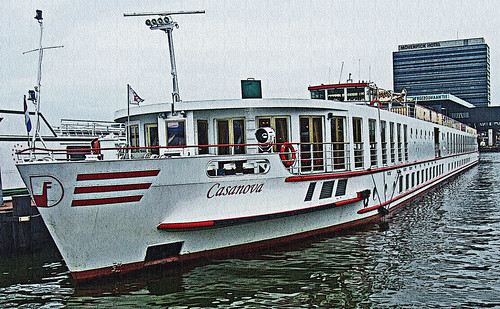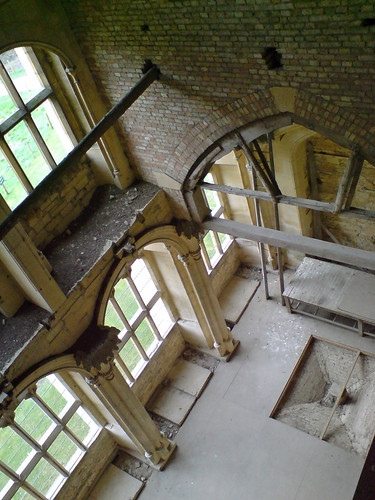MS Casanova / Peter Deilmann Reederei / Docked at Amsterdam
Image by bill barber
From my set entitled “Amsterdam”
www.flickr.com/photos/21861018@N00/sets/72157602418470116/
In my collection entitled “Rhine Main Danube”
www.flickr.com/photos/21861018@N00/collections/7215760702...
In my photostream
www.flickr.com/photos/21861018@N00/
Just over a year ago, Karen and I cruised the Rhine-Main-Danube System. The tour covered the following countries: Netherlands, Germany, Austria and Hungary. The cities we visited included Amsterdam, Xanten, Cologne, Koblenz, Aschaffenburg, Wurzburg, Bamberg, Nuremburg, Regensburg, Passau, Vienna and Budapest. It was a lovely trip, and I came home with over 2000 photos, most of which I posted between October, 2007 and May, 2008.
The following articles deal with our ship, The MS Casanova, operated by Peter Deilmann Reederei
Reproduced from Deilmann Casanova Review
By Durant and Cheryl Imboden
www.riverdiscounts.com/5496294_14881.htm
Peter Deilmann Reederei has operated cruise vessels on European rivers since 1983, when the Donauprinzessin joined the line's existing fleet of ocean ships. Today, the company has 10 ships on the rivers of Western and Central Europe, together with two luxurious ocean vessels: the MS Deutschland and the sailing yacht Lili Marleen.
In fall, 2004, my son and I spent a week aboard the MS Casanova, a five-star river vessel that moved from Northern Italy to the Rhine, Danube, Moselle, and Rhine-Main Canal for the 2005 season and beyond. This illustrated review describes the ship, the service and amenities onboard, and the distinctly European style of river cruising that Peter Deilmann offers to cosmopolitan travelers.
MS Casanova: the ship
Casanova was built in 2001 for cruises on Italy's Po River, where ships must be able to cruise under low bridges and fit comfortably in narrow, shallow canals. As a result, it's smaller than many ships that cruise Central European waters, with a length of 338 feet and a beam of 32 feet, or 103 m by 9,70 m. The ship could be described as a "boutique vessel," since it accommodates only 96 passengers.
Most public rooms are on the Verdi deck, or main deck, which also has 26 of the the ship's 48 passenger cabins. A staircase leads down to the Rialto Deck, where a foyer separates the restaurant from the 22 lower-deck staterooms. The Sundeck, an open area on the top of the ship, offers deck chairs, tables, and plenty of space along the railings for sightseeing and picture-taking.
Passengers enter and leave the ship via the reception area, located amidships on the Verdi deck, which acts as a buffer between the public rooms and cabins. A doorway on the starboard side of Casanova leads past a boutique/hairdresser into the large and well-appointed lounge, which has a bar, a library corner, a small dance floor, and a piano for entertainment.
Audience and ambience
Like other Peter Deilmann river vessels, Casanova serves a multinational audience. This makes it different from its leading competitors on the European river-cruising circuit, which operate separate vessels for the U.S. and Canadian market (Viking) or cater only to North American travelers (Avalon Waterways, Uniworld, Vantage, etc.).
The bulk of Deilmann's guests come from German-speaking countries, but a substantial minority are from the U.S., Canada, and Britain. On our cruise, about a third of the passengers were American or Canadian, with one British couple on board. Most of our fellow guests were in their 60s or older (a fairly typical age range for European river cruises).
The ship's ambience has a strong German flavor, but don't go looking for stereotypes from yesteryear: The waiters, stewardesses, and reception staff are more friendly than formal, and the dress code on most evenings is "smart casual." You'll notice the Teutonic influence mostly when you turn on the TV--where German channels predominate--or if you request water in the restaurant, when you'll be asked if you want bottled mineral water or American-style ice water. (After the first meal or two, your beverage stewardess will remember your preferences.)
All ship's announcements are in both German and English, and separate versions of the daily newsletter are published for Deutsch- and English-speaking guests.
Overall, Casanova and Peter Deilmann Cruises offer a more cosmopolitan atmosphere than you'd find on a vessel that caters primarily to U.S. and Canadian travelers. With Deilmann, you feel that you're in Europe when you're aboard the ship, not just when you go ashore. Whether that's good or bad depends on your tastes and whether you prefer mingling with the locals or sticking with fellow foreigners.
Casanova's staterooms come in three flavors:
Queen cabins. In these 16 staterooms, the queen-size beds have separate mattresses, each with its own duvet when the stewardess removes the bedspread at night. This means you can snuggle or maintain separation, depending on whom you're traveling with.
Twin cabins. These 30 cabins have twin beds on opposite walls. One berth converts into a sofa during the day.
Junior suites. There are just two junior suites, both on the lower or Rialto deck. They have queen-size beds and are slightly larger than the standard queen and twin cabins.
Rooms on the Verdi or upper deck have cleverly designed French doors overlooking the water. Open the left half, and you have a floor-to-ceiling screen to keep bugs at bay. Open the right side, and you can lean out to take pictures, check the passing landscape in more detail, or get a feel for the weather.
Cabins on the Rialto or lower deck have fixed picture windows.
All staterooms are attractively decorated with generous expanses of wood paneling, drapes, pictures on the walls, etc. Casanova's designers gave a lot of attention to details, as the inset photo of a ceiling light will show. The gold-trim motif is also used on the custom cabin furniture, which includes built-in closets, nightstands with storage space, and a desk with minibar. (I did notice one small oversight: Casanova's duvets are filled with a thin polyester batting instead of down.)
The bathrooms are extremely well-designed, with luxury touches such as glass shower enclosures, marble and ceramic walls, wooden toilet seats, brass faucets, and sinks that have marble countertops in a beautiful brown-red marble above a wooden storage cabinet and shelves. There's a retractable clothesline in the shower stall, and you'll find plenty of racks and hooks for towels and dressing gowns. (Your stewardess will supply bathrobes on request.)
Finally, the TV in each cabin has a good assortment of channels--mostly in German, but with BBC World and CNN to keep you in touch with what's happening back home. Casanova also has closed-circuit movies several times a day in both German and English.
Dining
Germans have a reputation for taking their food seriously, and the quality of hotel and restaurant food in Germany tends to be much better than in the United States or Britain. So it shouldn't come as a surprise that Peter Deilmann's Casanova lives up to its five-star ambitions in the dining room.
Breakfast consists of a buffet with fresh fruit, cereals, rolls, dark German breads, croissants and other pastries, cheeses, cold cuts, herring, smoked salmon, etc. Waiters are on hand to serve beverages, whisk away dirty plates, and take orders for fresh-cooked eggs or daily specials. Mineral water and sparkling wine, which you pay for at lunch or dinner, are free at breakfast. (Nicole, our beverage stewardess, told us that some guests like a glass of Prosecco to wake up in the morning. I tried a quarter-glass as a test but decided to stick with coffee. My son was pleased by the hot chocolate, which was excellent.)
Lunch is a choose-your-own-adventure affair where you can fill up a plate from the buffet or have a full meal served course by course. On most days, I grabbed a few salad and fish items from the buffet and skipped directly to the main course or requested pasta as an entrée.
At dinner, the menu typically features an appetizer, two soups, a fish or pasta course, a choice of entrées, and dessert. (On gala nights, a sorbet precedes the main course.) The restaurant's wood-and-marble buffet table is laid with a salad bar (with the term "salad" encompassing such luxuries as shrimp and fish), which is replaced by a selection of cheeses and fruit at the end of the meal.
Deilmann doesn't skimp on ingredients: High-quality fish is on the menu at nearly every midday or evening meal, and we were served lobster, large shrimp, lamb, veal, and duck at various times during the cruise. Baked goods are also excellent--most notably the cakes and other desserts, which are baked on board by a full-time pastry chef.
If sightseeing leaves you hungry for more than three square meals a day, you can top up your tummy with boullion at 11 a.m., finger sandwiches and cakes at afternoon tea, or the late-night snack in the lounge at 10:30 p.m. (On our voyage, Jozef--the Casanova's excellent pianst and vocalist--offered musical accompaniment during afternoon tea, the 6:30 p.m. cocktail hour, and the evening snack.)
About beverages:
Coffee, tea, ice water, and fruit juices are free. Other drinks cost extra at lunch and dinner, although complimentary sparkling wine and Kir Royale are served (and replenished generously) on gala nights. If you order a bottle of wine or mineral water in the dining room, your waiter will mark the bottle and save it for future meals.
Drink prices are in line with what you might expect on a European luxury vessel: On our cruise, a glass of German draft beer cost €2,80, a bar-size bottle of soft drink was €2,50, a 5-cl glass of vermouth cost €2,90, grappa was €3,80, and whiskies or cocktails were in the €5,50 to €6,90 range. Featured wines on the dinner menu typically cost €20 to €25, and a quarter-liter of the house white or red was less expensive than a glass of wine in a typical U.S. restaurant.
Service
Casanova has an unusually large staff for a river ship that carries only 96 passengers. Peter Deilmann claims a passenger-to-crew ratio of 2.5:1, or "about the best crew to passenger ratio of any river vessel." There's even a physician on board.
The multilingual restaurant, bar, housekeeping, and reception staff were a hardworking bunch during our cruise, and they were also highly-trained professionals. Our waiter, Mladen Tomljanovic, was a nine-year veteran of cruise ships, and our beverage stewardess, Nicole Hoppe, had three years of professional education and apprenticeship before joining Peter Deilmann Cruises. Mladen, Nicole, and other members of the restaurant and beverage staff worked together as an efficient team, delivering service on a par with what you'd expect on a luxury cruise line or a five-star hotel.
I was also impressed by the crew's warmth, friendliness, and overall good cheer. One evening, the younger staff were kind enough to invite my 18-year-old son to join them at a nightclub that was popular with riverboat crews. (I resisted the urge to play chaperone, spending the evening with a Donna Leon mystery instead.)
Tipping suggestions:
The Casanova's newsletter recommended dividing gratuities of €6,50 to €7,50 per passenger per day among the service staff, and passengers were encouraged to make additional contributions to a tips box at the reception desk for other members of the crew. I thought the recommended figures were a bit low for staff who worked 15 hours or more per day, so I gave €50 each (for two passengers) to our waiter, beverage stewardess, and cabin stewardess, plus another €50 for the crew box.
(Note: Tips for bar purchases should be made at the time of service, since the person who serves you a drink may not be your regular beverage stewardess or waiter.)
From Professional Travel Guide
www.professionaltravelguide.com/Cruise/Cruise-Lines/Peter...
This German-built river boat from Peter Deilmann Cruises launched in 2001 and was refitted in 2006. She sails with up to 96 passengers on a wide variety of itineraries along the Rhine, Moselle, Main and Danube rivers from mid-March to early November. This slim, trim triple-decker is an all-white 338-ft beauty with red trim. She has a width of 32 ft and a draft of 4 ft and shows a classical profile.
Peter Deilmann founded this German company a quarter century ago, first with oceangoing cruise ships and then riverboats. His two daughters carry on the tradition from the company headquarters at Neustadt in Holsetin, Germany operating eight high-end riverboats and the cruise ship Deutschland.
North American and German speakers come aboard in varying numbers depending on the itinerary and departure. Most are 50 and older. Very few children are found aboard, and there are no special facilities for them. The riverboat crew is fully bilingual, so there are no language problems. Suggested per diem tipping rates are US for waitstaff and US for the cabin attendant.
The Casanova used to sail on the River Po in northern Italy, and now she is found plying many different itineraries lasting from 7 to 14 days. She may be based at Amsterdam, The Netherlands, for cruises on the Dutch and Belgian waterways or along the Rhine and Main in Germany. She sails with the Mozart on 7-day Danube River trips based at Passau, Germany.
Her most ambitious cruise is a pair of sailings between Amsterdam and Budapest, Hungary, via the Rhine, Main, Danube and connecting canal. Some shore excursions are included in cruise-tours but not for cruise-only fares. A money-saving tour package can be bought for most itineraries. Depending on the numbers, the buses may be separate for each language or bilingual, and the same goes for the guided walks.
The panoramic restaurant has a stately Italian Provincial elegance with classic highback chairs and cherry accents, a circular compass rose of yellow glass on the ceiling and a buffet station. The room can accommodate all passengers at a single sitting. No one has time to get hungry, with breakfast, morning bouillon, lunch, tea, dinner and midnight snacks. Excellent multicourse luncheons and dinners feature Continental fare and wines of many countries. Evening meals can feature nine courses on some nights, so expect to spend a lot of time at the table.
English-speaking passengers are seated together at reserved tables and single sitting. Evening wear often sees men in jacket and tie. The tastefully furnished lounge brings passengers together several times a day, with its plump sofas and armchairs, panoramic views, well-stocked bar, and nightly entertainment and dancing. Announcements, menus, and daily programs are all provided in English and German.
The sun deck topside has plenty of deck chairs and blankets, and a doctor is onboard. Standard cabins are 140 sq ft, with two minisuites of 160 sq ft, all beautifully appointed with desks, TVs, phones, radios, closets, and baths with showers, hair dryers and robes. Beds are twins and queen-sized, and the upper deck cabins have French doors. Bedding is European-style with duvets and feather pillows, but synthetic materials are available upon request.
As of 2008, there is no smoking inside any Deilmann vessels. Smoking is only allowed on deck.
Post processing:
PhotoShop Elements 5: increased midtones, sharpened, posterized, canvas filter
From above, looking down into the dining room
Image by Ramones Karaoke
In around 1854 William Leigh, a recent convert to Roman Catholicism, had the idea of creating a grand Gothic mansion in Woodchester Park, incorporating a large and fabulous chapel.
Sadly, 20 years into its design and construction he passed away, and the house still stands, unfinished. The house is open to the public, and makes an amazing tour.
Being on the upper floors was pretty amazing - the walkways were the vaulted arches on the ceiling below. Very odd.
As you might guess, a place as perfectly ruined as this has bats - and lots of them. A significant chunk of the British breeding population of Greater Horseshoes comes here to have and bring up their babies, from as far afield as Symonds Yat in the Forest of Dean.
3 Zlin (27)
Image by TijsB
View on the factory buildings from the high skyscraper of Zlín.
Zlin is unique for its functionalist architecture. Due to the social management of the Bat'a's factories every family in Zlín was able to live in a comfortable house. Baťa himself was elected mayor of Zlín in 1923. He hired leading architects in order to develop a modern city, which even today remains one of the best examples of constructivism.
The city has remained the same since the 1920s and 30s. Architects like Karfik, Gahura, Kotera, Lorenc and Le Corbusier designed and constructed the most famous buildings. They are typical un-plastered red brickwork, with a concrete skeleton, flat roof and steel window frames.
3 Zlin (26)
Image by TijsB
View on office and company buildings from the high skyscraper of Zlín.
Zlin is unique for its functionalist architecture. Due to the social management of the Bat'a's factories every family in Zlín was able to live in a comfortable house. Baťa himself was elected mayor of Zlín in 1923. He hired leading architects in order to develop a modern city, which even today remains one of the best examples of constructivism.
The city has remained the same since the 1920s and 30s. Architects like Karfik, Gahura, Kotera, Lorenc and Le Corbusier designed and constructed the most famous buildings. They are typical un-plastered red brickwork, with a concrete skeleton, flat roof and steel window frames.
3 Zlin (28)
Image by TijsB
View on office and company buildings from the high skyscraper of Zlín.
Zlin is unique for its functionalist architecture. Due to the social management of the Bat'a's factories every family in Zlín was able to live in a comfortable house. Baťa himself was elected mayor of Zlín in 1923. He hired leading architects in order to develop a modern city, which even today remains one of the best examples of constructivism.
The city has remained the same since the 1920s and 30s. Architects like Karfik, Gahura, Kotera, Lorenc and Le Corbusier designed and constructed the most famous buildings. They are typical un-plastered red brickwork, with a concrete skeleton, flat roof and steel window frames.
No comments:
Post a Comment